octane Seat Alhambra 2015 Owner's Manual
[x] Cancel search | Manufacturer: SEAT, Model Year: 2015, Model line: Alhambra, Model: Seat Alhambra 2015Pages: 305, PDF Size: 5.46 MB
Page 155 of 305
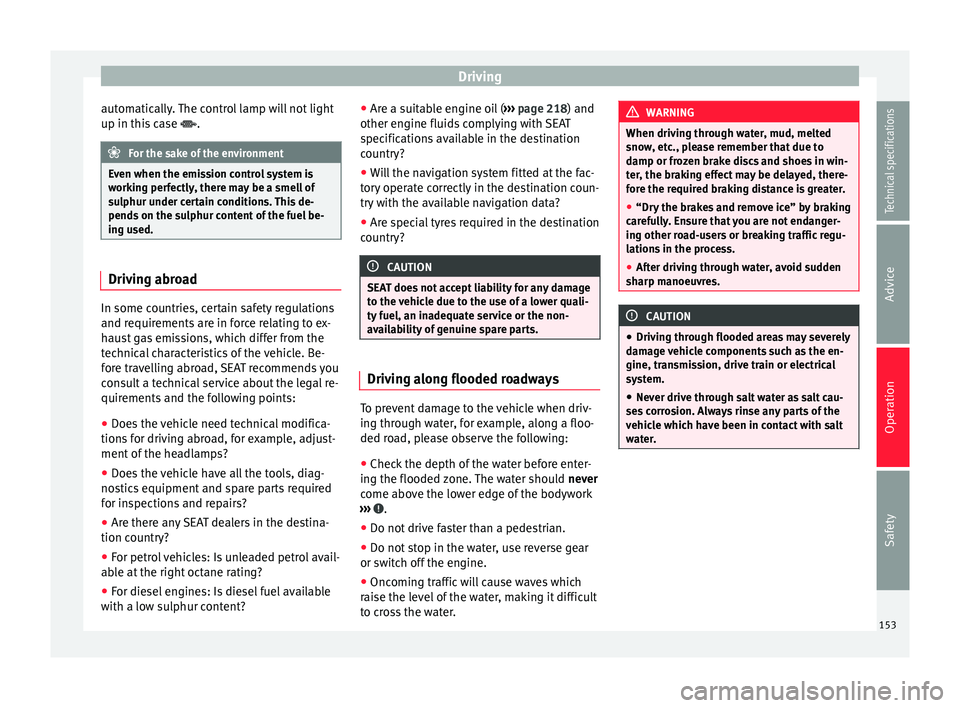
Driving
automatically. The control lamp will not light
up in this case . For the sake of the environment
Even when the emission control system is
working perfectly, there may be a smell of
sulphur under certain conditions. This de-
pends on the sulphur content of the fuel be-
ing used. Driving abroad
In some countries, certain safety regulations
and requirements are in force relating to ex-
haust gas emissions, which differ from the
technical characteristics of the vehicle. Be-
fore travelling abroad, SEAT recommends you
consult a technical service about the legal re-
quirements and the following points:
●
Does the vehicle need technical modifica-
tions for driving abroad, for example, adjust-
ment of the headlamps?
● Does the vehicle have all the tools, diag-
nostics equipment and spare parts required
for inspections and repairs?
● Are there any SEAT dealers in the destina-
tion country?
● For petrol vehicles: Is unleaded petrol avail-
able at the right octane rating?
● For diesel engines: Is diesel fuel available
with a low sulphur content? ●
Are a suitable engine oil ( ››› page 218) and
other engine fluids complying with SEAT
specifications available in the destination
country?
● Will the navigation system fitted at the fac-
tory operate correctly in the destination coun-
try with the available navigation data?
● Are special tyres required in the destination
country? CAUTION
SEAT does not accept liability for any damage
to the vehicle due to the use of a lower quali-
ty fuel, an inadequate service or the non-
availability of genuine spare parts. Driving along flooded roadways
To prevent damage to the vehicle when driv-
ing through water, for example, along a floo-
ded road, please observe the following:
● Check the depth of the water before enter-
ing the flooded zone. The water should never
come above the lower edge of the bodywork
››› .
● Do not drive faster than a pedestrian.
● Do not stop in the water, use reverse gear
or switch off the engine.
● Oncoming traffic will cause waves which
raise the level of the water, making it difficult
to cross the water. WARNING
When driving through water, mud, melted
snow, etc., please remember that due to
damp or frozen brake discs and shoes in win-
ter, the braking effect may be delayed, there-
fore the required braking distance is greater.
● “Dry the brakes and remove ice” by braking
carefully. Ensure that you are not endanger-
ing other road-users or breaking traffic regu-
lations in the process.
● After driving through water, avoid sudden
sharp manoeuvres. CAUTION
● Driving through flooded areas may severely
damage vehicle components such as the en-
gine, transmission, drive train or electrical
system.
● Never drive through salt water as salt cau-
ses corrosion. Always rinse any parts of the
vehicle which have been in contact with salt
water. 153Technical specifications
Advice
Operation
Safety
Page 211 of 305
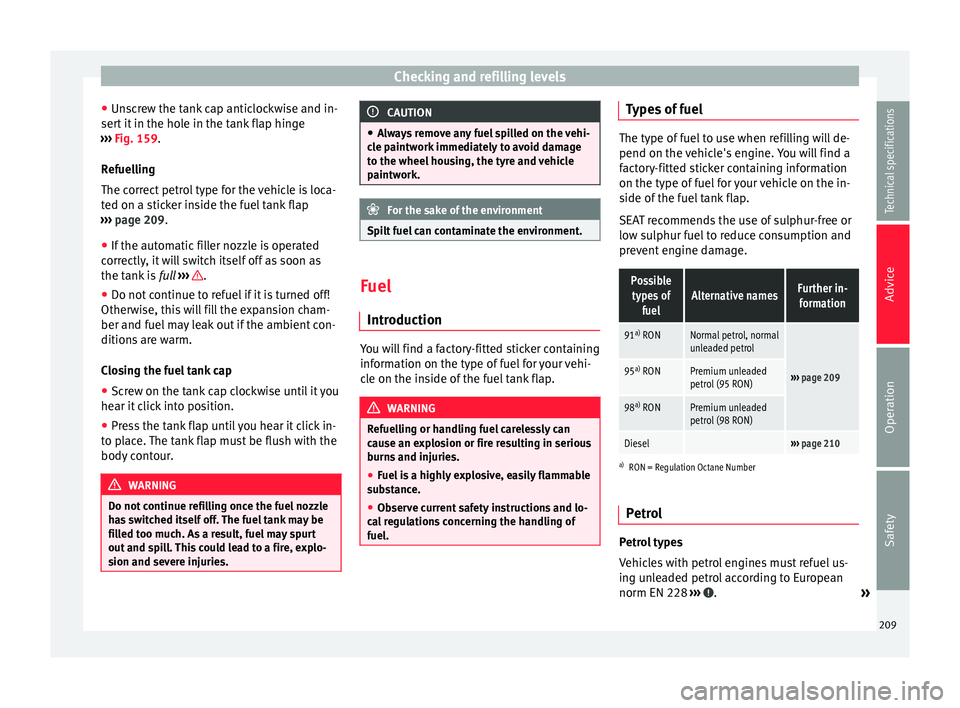
Checking and refilling levels
● Unscrew the tank cap anticlockwise and in-
sert it in the hole in the tank flap hinge
››› Fig. 159 .
R ef
uelling
The correct petrol type for the vehicle is loca-
ted on a sticker inside the fuel tank flap
››› page 209.
● If the aut
omatic filler nozzle is operated
correctly, it will switch itself off as soon as
the tank is full ››› .
● Do not continue to refuel if it is turned off!
Otherwise, this will fill the expansion cham-
ber and fuel may leak out if the ambient con-
ditions are warm.
Closing the fuel tank cap
● Screw on the tank cap clockwise until it you
hear it click into position.
● Press the tank flap until you hear it click in-
to place. The tank flap must be flush with the
body contour. WARNING
Do not continue refilling once the fuel nozzle
has switched itself off. The fuel tank may be
filled too much. As a result, fuel may spurt
out and spill. This could lead to a fire, explo-
sion and severe injuries. CAUTION
● Always remove any fuel spilled on the vehi-
cle paintwork immediately to avoid damage
to the wheel housing, the tyre and vehicle
paintwork. For the sake of the environment
Spilt fuel can contaminate the environment. Fuel
Introduction You will find a factory-fitted sticker containing
information on the type of fuel for your vehi-
cle on the inside of the fuel tank flap.
WARNING
Refuelling or handling fuel carelessly can
cause an explosion or fire resulting in serious
burns and injuries.
● Fuel is a highly explosive, easily flammable
substance.
● Observe current safety instructions and lo-
cal regulations concerning the handling of
fuel. Types of fuel
The type of fuel to use when refilling will de-
pend on the vehicle's engine. You will find a
factory-fitted sticker containing information
on the type of fuel for your vehicle on the in-
side of the fuel tank flap.
SEAT recommends the use of sulphur-free or
low sulphur fuel to reduce consumption and
prevent engine damage.
Possible
types of fuelAlternative namesFurther in-formation
91 a)
RONNormal petrol, normal
unleaded petrol
››› page 20995 a)
RONPremium unleaded
petrol (95 RON)
98 a)
RONPremium unleaded
petrol (98 RON)
Diesel ››› page 210
a)
RON = Regulation Octane Number
Petrol Petrol types
Vehicles with petrol engines must refuel us-
ing unleaded petrol according to European
norm EN 228
››› .
»
209
Technical specifications
Advice
Operation
Safety
Page 212 of 305
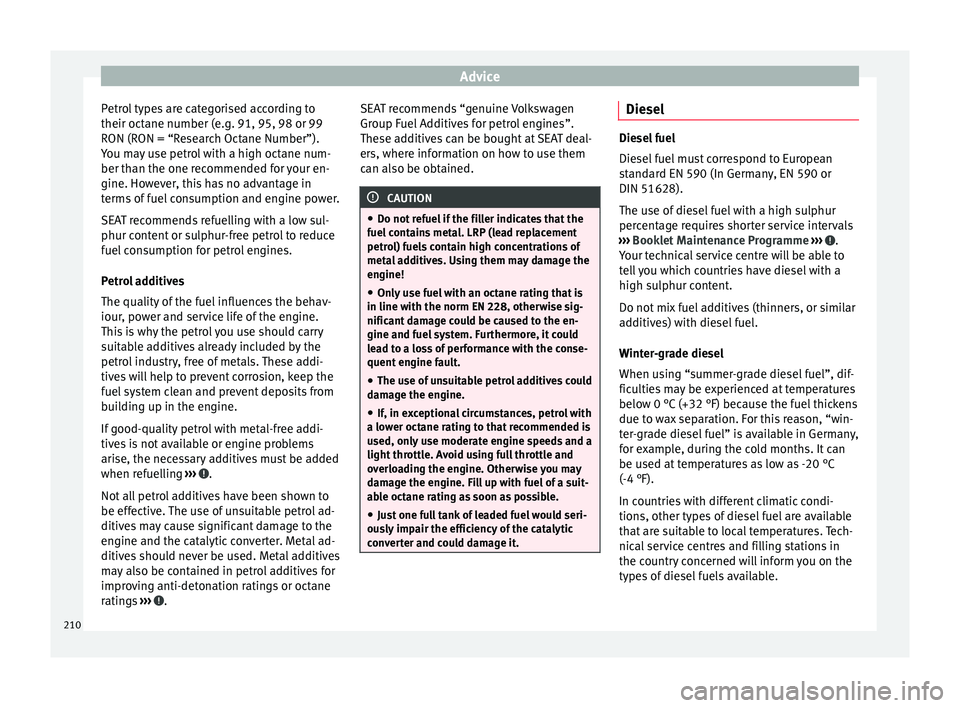
Advice
Petrol types are categorised according to
their octane number (e.g. 91, 95, 98 or 99
RON (RON = “Research Octane Number”).
You may use petrol with a high octane num-
ber than the one recommended for your en-
gine. However, this has no advantage in
terms of fuel consumption and engine power.
SEAT recommends refuelling with a low sul-
phur content or sulphur-free petrol to reduce
fuel consumption for petrol engines.
Petrol additives
The quality of the fuel influences the behav-
iour, power and service life of the engine.
This is why the petrol you use should carry
suitable additives already included by the
petrol industry, free of metals. These addi-
tives will help to prevent corrosion, keep the
fuel system clean and prevent deposits from
building up in the engine.
If good-quality petrol with metal-free addi-
tives is not available or engine problems
arise, the necessary additives must be added
when refuelling ››› .
Not all petrol additives have been shown to
be effective. The use of unsuitable petrol ad-
ditives may cause significant damage to the
engine and the catalytic converter. Metal ad-
ditives should never be used. Metal additives
may also be contained in petrol additives for
improving anti-detonation ratings or octane
ratings ››› . SEAT recommends “genuine Volkswagen
Group Fuel Additives for petrol engines”.
These additives can be bought at SEAT deal-
ers, where information on how to use them
can also be obtained.
CAUTION
● Do not refuel if the filler indicates that the
fuel contains metal. LRP (lead replacement
petrol) fuels contain high concentrations of
metal additives. Using them may damage the
engine!
● Only use fuel with an octane rating that is
in line with the norm EN 228, otherwise sig-
nificant damage could be caused to the en-
gine and fuel system. Furthermore, it could
lead to a loss of performance with the conse-
quent engine fault.
● The use of unsuitable petrol additives could
damage the engine.
● If, in exceptional circumstances, petrol with
a lower octane rating to that recommended is
used, only use moderate engine speeds and a
light throttle. Avoid using full throttle and
overloading the engine. Otherwise you may
damage the engine. Fill up with fuel of a suit-
able octane rating as soon as possible.
● Just one full tank of leaded fuel would seri-
ously impair the efficiency of the catalytic
converter and could damage it. Diesel
Diesel fuel
Diesel fuel must correspond to European
standard EN 590 (In Germany, EN 590 or
DIN 51628).
The use of diesel fuel with a high sulphur
percentage requires shorter service intervals
››› Booklet Maintenance Programme ››› .
Your technical service centre will be able to
tell you which countries have diesel with a
high sulphur content.
Do not mix fuel additives (thinners, or similar
additives) with diesel fuel.
Winter-grade diesel
When using “summer-grade diesel fuel”, dif-
ficulties may be experienced at temperatures
below 0 °C (+32 °F) because the fuel thickens
due to wax separation. For this reason, “win-
ter-grade diesel fuel” is available in Germany,
for example, during the cold months. It can
be used at temperatures as low as -20 °C
(-4 °F).
In countries with different climatic condi-
tions, other types of diesel fuel are available
that are suitable to local temperatures. Tech-
nical service centres and filling stations in
the country concerned will inform you on the
types of diesel fuels available.
210
Page 276 of 305
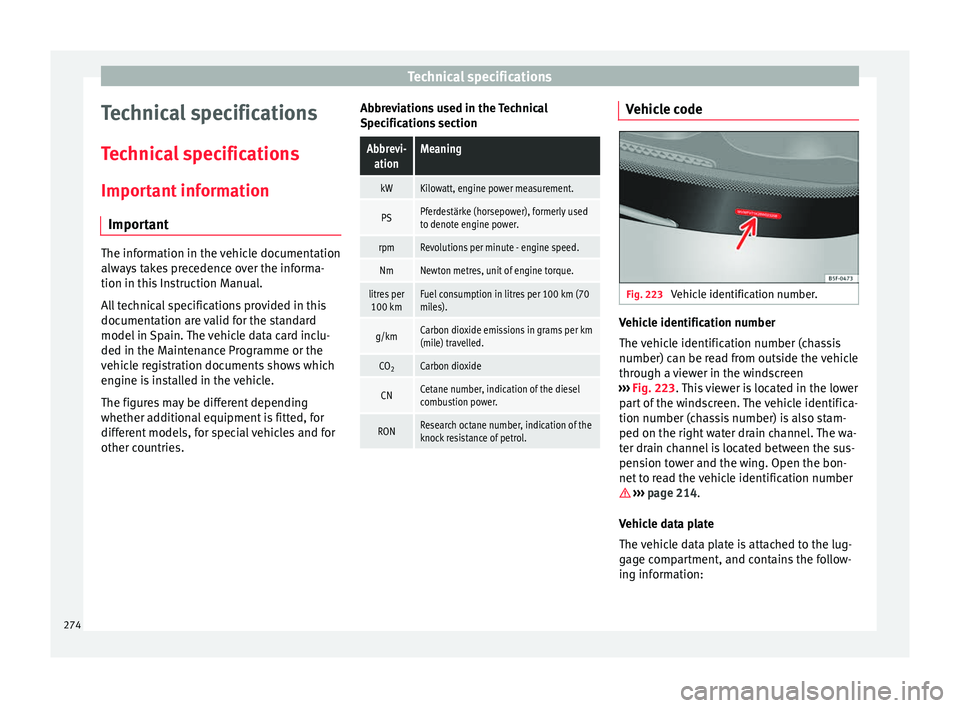
Technical specifications
Technical specifications
Technical specifications
Important information Important The information in the vehicle documentation
always takes precedence over the informa-
tion in this Instruction Manual.
All technical specifications provided in this
documentation are valid for the standard
model in Spain. The vehicle data card inclu-
ded in the Maintenance Programme or the
vehicle registration documents shows which
engine is installed in the vehicle.
The figures may be different depending
whether additional equipment is fitted, for
different models, for special vehicles and for
other countries.
Abbreviations used in the Technical
Specifications sectionAbbrevi-
ationMeaning
kWKilowatt, engine power measurement.
PSPferdestärke (horsepower), formerly used
to denote engine power.
rpmRevolutions per minute - engine speed.
NmNewton metres, unit of engine torque.
litres per100 kmFuel consumption in litres per 100 km (70
miles).
g/kmCarbon dioxide emissions in grams per km
(mile) travelled.
CO 2Carbon dioxide
CNCetane number, indication of the diesel
combustion power.
RONResearch octane number, indication of the
knock resistance of petrol. Vehicle code
Fig. 223
Vehicle identification number. Vehicle identification number
The vehicle identification number (chassis
number) can be read from outside the vehicle
through a viewer in the windscreen
››› Fig. 223 . This viewer is located in the lower
p ar
t of the windscreen. The vehicle identifica-
tion number (chassis number) is also stam-
ped on the right water drain channel. The wa-
ter drain channel is located between the sus-
pension tower and the wing. Open the bon-
net to read the vehicle identification number
››› page 214.
Vehic
le data plate
The vehicle data plate is attached to the lug-
gage compartment, and contains the follow-
ing information:
274
Page 279 of 305
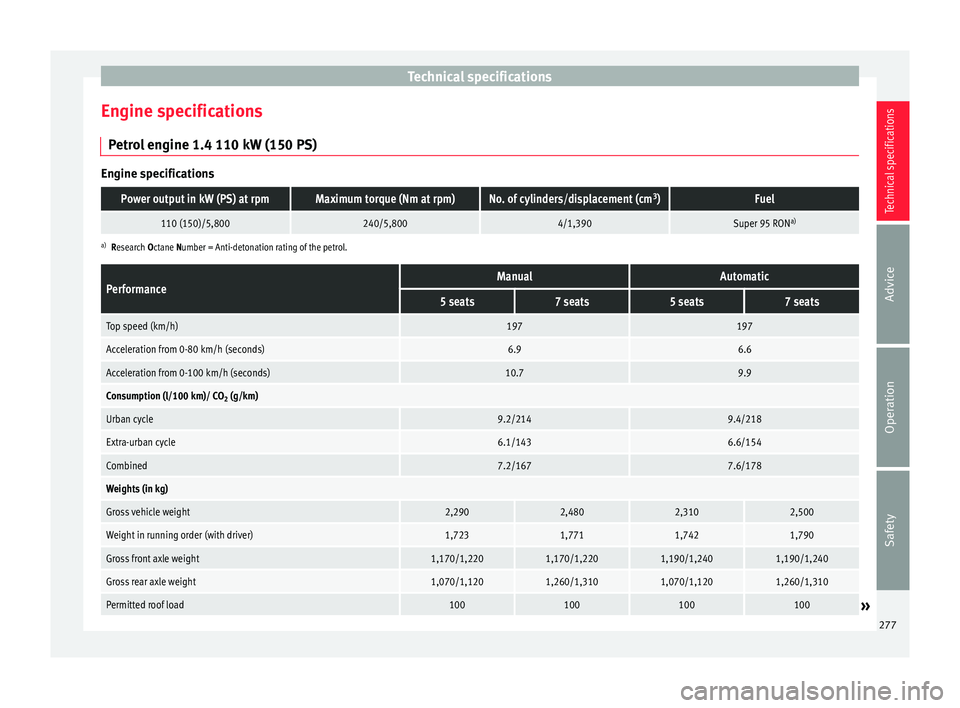
Technical specifications
Engine specifications Petrol engine 1.4 110 kW (150 PS) Engine specificationsPower output in kW (PS) at rpmMaximum torque (Nm at rpm)No. of cylinders/displacement (cm
3
)Fuel
110 (150)/5,800240/5,8004/1,390Super 95 RON a)
a)
Research Octane Number = Anti-detonation rating of the petrol.
PerformanceManualAutomatic
5 seats7 seats5 seats7 seats
Top speed (km/h)197197
Acceleration from 0-80 km/h (seconds)6.96.6
Acceleration from 0-100 km/h (seconds)10.79.9
Consumption (l/100 km)/ CO 2 (g/km)
Urban cycle9.2/2149.4/218
Extra-urban cycle6.1/1436.6/154
Combined7.2/1677.6/178
Weights (in kg)
Gross vehicle weight2,2902,4802,3102,500
Weight in running order (with driver)1,7231,7711,7421,790
Gross front axle weight1,170/1,2201,170/1,2201,190/1,2401,190/1,240
Gross rear axle weight1,070/1,1201,260/1,3101,070/1,1201,260/1,310
Permitted roof load100100100100» 277
Technical specifications
Advice
Operation
Safety
Page 280 of 305
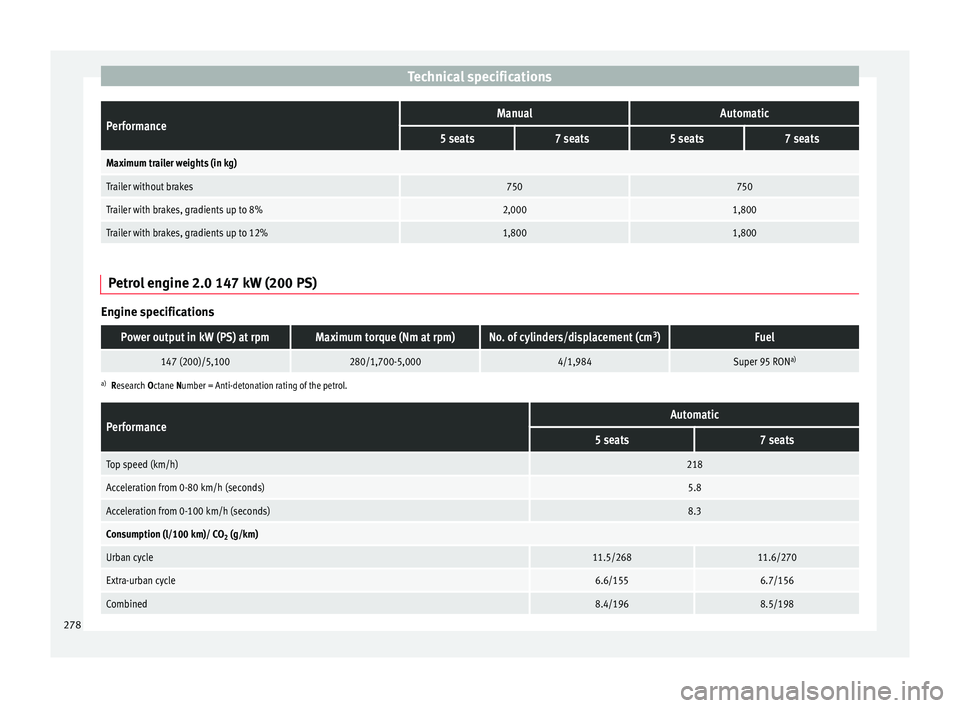
Technical specificationsPerformanceManualAutomatic
5 seats7 seats5 seats7 seats
Maximum trailer weights (in kg)
Trailer without brakes750750
Trailer with brakes, gradients up to 8%2,0001,800
Trailer with brakes, gradients up to 12%1,8001,800
Petrol engine 2.0 147 kW (200 PS)
Engine specifications
Power output in kW (PS) at rpmMaximum torque (Nm at rpm)No. of cylinders/displacement (cm
3
)Fuel
147 (200)/5,100280/1,700-5,0004/1,984Super 95 RON a)
a)
Research Octane Number = Anti-detonation rating of the petrol.
PerformanceAutomatic
5 seats7 seats
Top speed (km/h)218
Acceleration from 0-80 km/h (seconds)5.8
Acceleration from 0-100 km/h (seconds)8.3
Consumption (l/100 km)/ CO 2 (g/km)
Urban cycle11.5/26811.6/270
Extra-urban cycle6.6/1556.7/156
Combined8.4/1968.5/198 278
Page 296 of 305
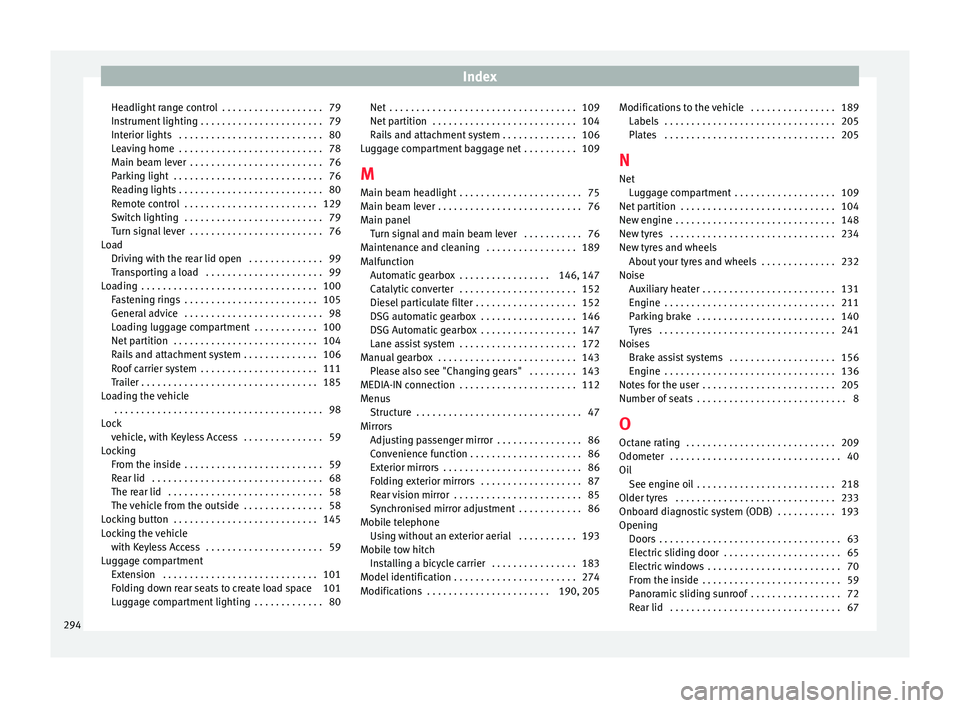
Index
Headlight range control . . . . . . . . . . . . . . . . . . . 79
Instrument lighting . . . . . . . . . . . . . . . . . . . . . . . 79
Interior lights . . . . . . . . . . . . . . . . . . . . . . . . . . . 80
Leaving home . . . . . . . . . . . . . . . . . . . . . . . . . . . 78
Main beam lever . . . . . . . . . . . . . . . . . . . . . . . . . 76
Parking light . . . . . . . . . . . . . . . . . . . . . . . . . . . . 76
Reading lights . . . . . . . . . . . . . . . . . . . . . . . . . . . 80
Remote control . . . . . . . . . . . . . . . . . . . . . . . . . 129
Switch lighting . . . . . . . . . . . . . . . . . . . . . . . . . . 79
Turn signal lever . . . . . . . . . . . . . . . . . . . . . . . . . 76
Load Driving with the rear lid open . . . . . . . . . . . . . . 99
Transporting a load . . . . . . . . . . . . . . . . . . . . . . 99
Loading . . . . . . . . . . . . . . . . . . . . . . . . . . . . . . . . . 100 Fastening rings . . . . . . . . . . . . . . . . . . . . . . . . . 105
General advice . . . . . . . . . . . . . . . . . . . . . . . . . . 98
Loading luggage compartment . . . . . . . . . . . . 100
Net partition . . . . . . . . . . . . . . . . . . . . . . . . . . . 104
Rails and attachment system . . . . . . . . . . . . . . 106
Roof carrier system . . . . . . . . . . . . . . . . . . . . . . 111
Trailer . . . . . . . . . . . . . . . . . . . . . . . . . . . . . . . . . 185
Loading the vehicle . . . . . . . . . . . . . . . . . . . . . . . . . . . . . . . . . . . . . . . 98
Lock vehicle, with Keyless Access . . . . . . . . . . . . . . . 59
Locking From the inside . . . . . . . . . . . . . . . . . . . . . . . . . . 59
Rear lid . . . . . . . . . . . . . . . . . . . . . . . . . . . . . . . . 68
The rear lid . . . . . . . . . . . . . . . . . . . . . . . . . . . . . 58
The vehicle from the outside . . . . . . . . . . . . . . . 58
Locking button . . . . . . . . . . . . . . . . . . . . . . . . . . . 145
Locking the vehicle with Keyless Access . . . . . . . . . . . . . . . . . . . . . . 59
Luggage compartment Extension . . . . . . . . . . . . . . . . . . . . . . . . . . . . . 101
Folding down rear seats to create load space 101
Luggage compartment lighting . . . . . . . . . . . . . 80 Net . . . . . . . . . . . . . . . . . . . . . . . . . . . . . . . . . . . 109
Net partition . . . . . . . . . . . . . . . . . . . . . . . . . . . 104
Rails and attachment system . . . . . . . . . . . . . . 106
Luggage compartment baggage net . . . . . . . . . . 109
M Main beam headlight . . . . . . . . . . . . . . . . . . . . . . . 75
Main beam lever . . . . . . . . . . . . . . . . . . . . . . . . . . . 76
Main panel Turn signal and main beam lever . . . . . . . . . . . 76
Maintenance and cleaning . . . . . . . . . . . . . . . . . 189
Malfunction Automatic gearbox . . . . . . . . . . . . . . . . . 146, 147
Catalytic converter . . . . . . . . . . . . . . . . . . . . . . 152
Diesel particulate filter . . . . . . . . . . . . . . . . . . . 152
DSG automatic gearbox . . . . . . . . . . . . . . . . . . 146
DSG Automatic gearbox . . . . . . . . . . . . . . . . . . 147
Lane assist system . . . . . . . . . . . . . . . . . . . . . . 172
Manual gearbox . . . . . . . . . . . . . . . . . . . . . . . . . . 143 Please also see "Changing gears" . . . . . . . . . 143
MEDIA-IN connection . . . . . . . . . . . . . . . . . . . . . . 112
Menus Structure . . . . . . . . . . . . . . . . . . . . . . . . . . . . . . . 47
Mirrors Adjusting passenger mirror . . . . . . . . . . . . . . . . 86
Convenience function . . . . . . . . . . . . . . . . . . . . . 86
Exterior mirrors . . . . . . . . . . . . . . . . . . . . . . . . . . 86
Folding exterior mirrors . . . . . . . . . . . . . . . . . . . 87
Rear vision mirror . . . . . . . . . . . . . . . . . . . . . . . . 85
Synchronised mirror adjustment . . . . . . . . . . . . 86
Mobile telephone Using without an exterior aerial . . . . . . . . . . . 193
Mobile tow hitch Installing a bicycle carrier . . . . . . . . . . . . . . . . 183
Model identification . . . . . . . . . . . . . . . . . . . . . . . 274
Modifications . . . . . . . . . . . . . . . . . . . . . . . 190, 205 Modifications to the vehicle . . . . . . . . . . . . . . . . 189
Labels . . . . . . . . . . . . . . . . . . . . . . . . . . . . . . . . 205
Plates . . . . . . . . . . . . . . . . . . . . . . . . . . . . . . . . 205
N
Net Luggage compartment . . . . . . . . . . . . . . . . . . . 109
Net partition . . . . . . . . . . . . . . . . . . . . . . . . . . . . . 104
New engine . . . . . . . . . . . . . . . . . . . . . . . . . . . . . . 148
New tyres . . . . . . . . . . . . . . . . . . . . . . . . . . . . . . . 234
New tyres and wheels About your tyres and wheels . . . . . . . . . . . . . . 232
Noise Auxiliary heater . . . . . . . . . . . . . . . . . . . . . . . . . 131
Engine . . . . . . . . . . . . . . . . . . . . . . . . . . . . . . . . 211
Parking brake . . . . . . . . . . . . . . . . . . . . . . . . . . 140
Tyres . . . . . . . . . . . . . . . . . . . . . . . . . . . . . . . . . 241
Noises Brake assist systems . . . . . . . . . . . . . . . . . . . . 156
Engine . . . . . . . . . . . . . . . . . . . . . . . . . . . . . . . . 136
Notes for the user . . . . . . . . . . . . . . . . . . . . . . . . . 205
Number of seats . . . . . . . . . . . . . . . . . . . . . . . . . . . . 8
O Octane rating . . . . . . . . . . . . . . . . . . . . . . . . . . . . 209
Odometer . . . . . . . . . . . . . . . . . . . . . . . . . . . . . . . . 40
Oil See engine oil . . . . . . . . . . . . . . . . . . . . . . . . . . 218
Older tyres . . . . . . . . . . . . . . . . . . . . . . . . . . . . . . 233
Onboard diagnostic system (ODB) . . . . . . . . . . . 193
Opening Doors . . . . . . . . . . . . . . . . . . . . . . . . . . . . . . . . . . 63
Electric sliding door . . . . . . . . . . . . . . . . . . . . . . 65
Electric windows . . . . . . . . . . . . . . . . . . . . . . . . . 70
From the inside . . . . . . . . . . . . . . . . . . . . . . . . . . 59
Panoramic sliding sunroof . . . . . . . . . . . . . . . . . 72
Rear lid . . . . . . . . . . . . . . . . . . . . . . . . . . . . . . . . 67
294